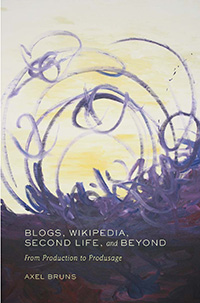You are here
New Impulses for Libraries: Drawing on Second Life and Produsage
(Crossposted from snurb.info.)
I'm spending the morning at the 2008 Arts Libraries Society of Australia and New Zealand conference, at the Queensland State Library. I'm afraid I'm only here for the opening keynotes (one of which I'm giving) - my hectic schedule for this week between overseas trips doesn't give me any more time to see what else is happening.
The first keynote speaker this morning is Kathryn Greenhill from Murdoch University, presenting on the possibilities of Second Life as a platform. She begins by taking us on a flight around Info Island - the central library island in Second Life - and follows this with a quick explanation of what Second Life is and how it works. The aim here, she notes, is immersion, not just information.
She also points out that Second Life is seriously overhyped, though - there's been a great deal of media interest in the space, pointing to commercial entities setting up spaces in SL, or highlighting issues with pornography and other unsavoury content. It's also important to note that there are some clear limitations, especially for Australian users with their relatively poor and expensive broadband services, and that growth in users has levelled off; at present, there are usually around 60-70,000 users online at any one time.
That said, there remain great opportunities, especially for libraries and librarians - and there are some 500 self-identified librarians online at the moment. Perhaps the most interesting aspect of Second Life is its immersive 3D environment, of course, and the ability for avatars to interact with one another and with objects in the virtual world. And there's a good amount of librarianship already taking place here - both regarding information about Second Life itself, tracking information and events outside of Second Life, and developing social networks around particular interests.
This also means that the Second Life spaces created in the process need to be populated, however, and that they need to be designed appropriately (the Australian library space didn't work particularly well, for example; subject area libraries do much better). Additionally, there's a need to move away from a very literal recreation of library spaces in Second Life - such spaces have little attraction for avatars used to more interesting environments elsewhere in Second Life.
Kathryn now shows a few examples here of interesting uses of Second Life - the incorporation of real-world environments like the Sistine Chapel into Second Life, as well as galleries of 'born digital' artworks. In fact, the Australia Council has now provided grants to artists to develop art works in Second Life - one of the outcomes has been the Babelswarm project, which draws on user chat conversations captured in the Babelswarm space.
This was also connected to an installation at Lismore Art Gallery, where gallery visitors were able to input text and voice into the Babelswarm environment. This opens possibilities for hybrid online/offline artworks utilising augmented reality technologies, and Kathryn shows another project now: SLARiPS, in which users interact with the Second Life space using hand-held tools. The challenge for librarians, Kathryn suggests, is this: How can such work be curated, archived, described, and tracked? How do we know what questions to ask about such work?
My own presentation started with a slight glitch - I had hoped to show a live feed of sites being bookmarked on Digg to show the continuous process of content curation that is taking place online. It's a beautiful little piece of data mining art, so please feel free to enjoy it in your own time!
Here, then, is my Powerpoint - with audio now online as well to follow later this week.
- Snurb's blog
- Log in to post comments
- 9675 reads
 Printer-friendly version
Printer-friendly version


